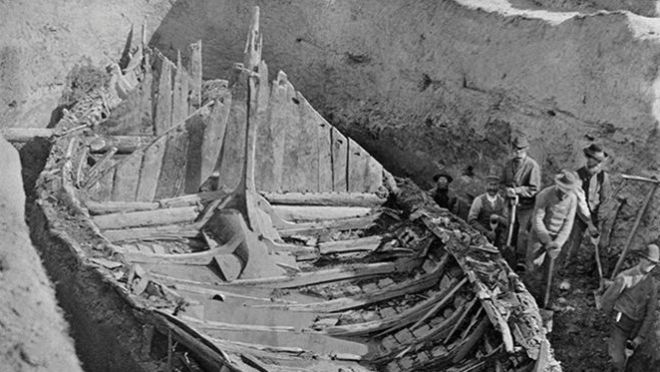There was a large burial mound on the Gokstad Farm near Sandefjord that people called the king's mound. It was said to contain treasure. In the autumn of 1879, two of the farmer’s sons started to dig into the mound to see if they could find anything interesting …. and they would have, had they had the chance to dig further. However, rumours of the dig spread all the way to the capital and antiquarian Nicolay Nicolaysen at the University's Collection of National Antiquities in Oslo managed to stop them by promising to carry out an excavation himself. In the spring of 1880, he started an archaeological excavation of the mound.
The burial mound around the ship had been built up with turf and sod. It was about five metres high and had a diameter of almost 45 metres. The mound was probably even larger in Viking times. The ship itself was buried the subsoil of blue clay in the subsoil, which meant that the ship and other grave goods had been kept damp and therefore well preserved. However, the top section of the ship’s side with its many shields - and both the stern and bow stems protruded above the clay and were therefore pretty much destroyed.
The Gokstad ship was built in about 890 CE, at the height of the Viking Age. In around the year 900 CE, a rich and powerful man died and was buried in the Gokstad ship. A burial chamber was built behind the mast. Here the deceased was laid out in a made bed. The deceased must have been dressed in an elaborate outfit when he was buried, but his weapons and jewellery were not found in the burial mound. Grave robbers had already been about their business in the Viking Age, but they didn’t get everything. A game board was found along with gaming pieces made of horn, along with fish hooks, parts of a harness made of iron, lead and gilded bronze - kitchen equipment, the remains of 64 shields, six beds, one tent and a sledge. The man was also accompanied to his grave by 12 horses, eight dogs, two northern goshawks and two peacocks.
The ship was made of oak and was clinker-built, with 16 rows of overlapping strakes, or planks. The nine strakes below the waterline are just two to three centimetres thick, and some of the ones higher up are even thinner. This made the ship’s side both light and flexible. The keel was made of an 18-metre long piece of oak.
